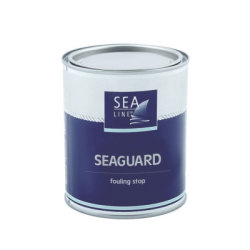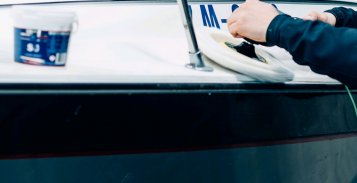
SEAGUARD FOULING STOP – a new anti-fouling paint for hulls.
Contrary to the traditional anti-fouling paints, SEAGUARD does not contain active ingredients, i.e. toxic biocides. The bottom paint is much more environmentally friendly, which is significant especially in the case of such reservoirs as lakes. It can also be used for fresh waters, coastal waters and salt waters. Modern solutions were applied in producing this paint which allowed to create a coating which will make it more difficult for lichens to maintain and develop on a surface. Sea-Line Seaguard works best for units moving with the speed not higher than of 30 knots and which are used often.
SEAGUARD is a self-polishing paint which is an extra benefit for users. It can be used for all types of yachts and boats – laminate, wood, steel and aluminium. It is available in 0,75 l and 2,5 l containers, navy blue and white colours. SEAGUARD is a paint which can safely be applied with air spraying and its advantage is high capability – up to 10m2 out of 1 litre.
The product was designed in view of the countries where anti-fouling paints containing biocides are forbidden and recalled. SEAGUARD FOULING STOP is compatible with the majority of available anti-fouling products and will be available from 10th March 2016.

Disculpa, pero esta entrada está disponible sólo en Polaco.

Come and join us at METSTRADE 2023, METSTRADE the best event for marine industry professionals, happening from November 15th to […]

Visit us and our production plant without traveling

New in the 2023 season is a new polishing wool The new black and white polishing pads in premium quality […]
There is a possibility of thinning antifouling, but we do not recommend this procedure due to the risk of reducing the effectiveness of the paint. If it is necessary to thin the antifouling paint, it is recommended to dilute it to a maximum of 0-5% (by volume).

Para rellenar cavidades y hacer frente a las desigualdades causadas por daños o durante el curso de la producción

Barcos de superficie de impacto de las actividades de ósmosis y la corrosión destructiva en ambientes hostiles

Protección contra el agua y contra los efectos negativos de los rayos UV

Proteger la parte inferior de la embarcación antes de las incrustaciones de algas y conchas. Protección contra el agua

Eliminación efectiva de arañazos, color refrescante y gelcoat brillo o pintura

Preparaciones especializados para la limpieza y restauración efectiva

Laminación, encolado y relleno de fisuras en gelcoat

Una serie de productos útiles durante el constructor de barcos de trabajo